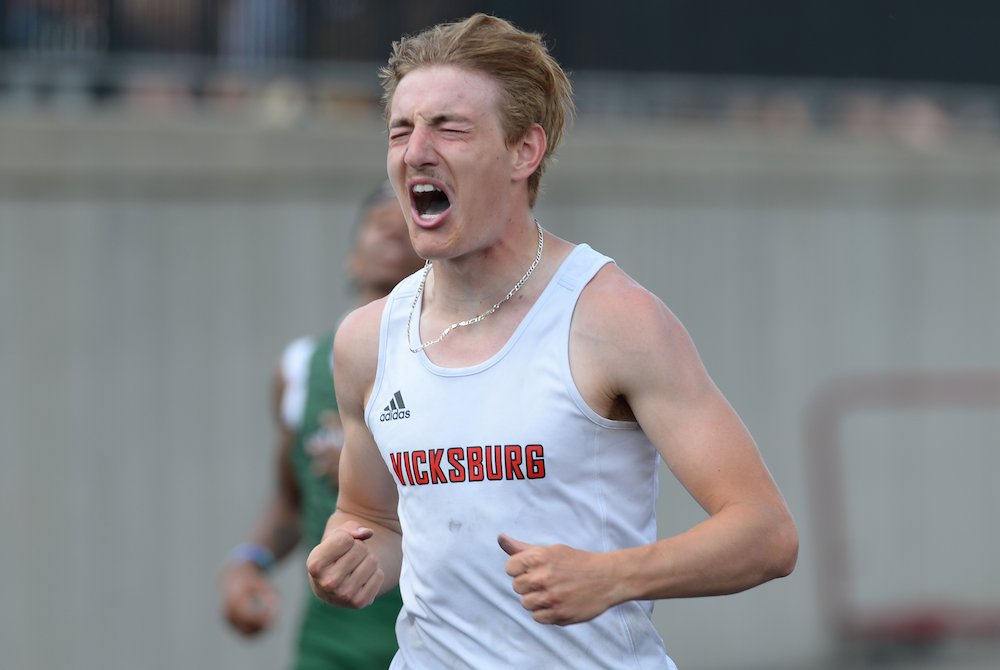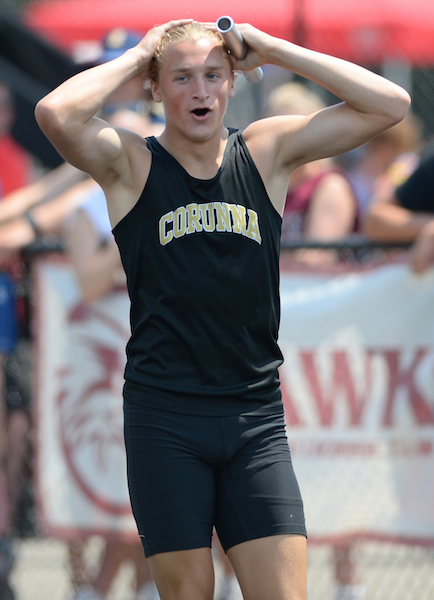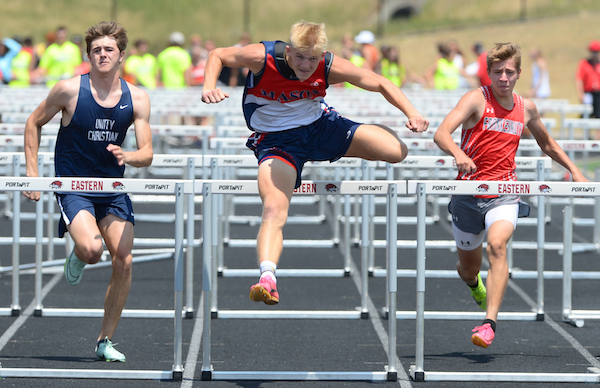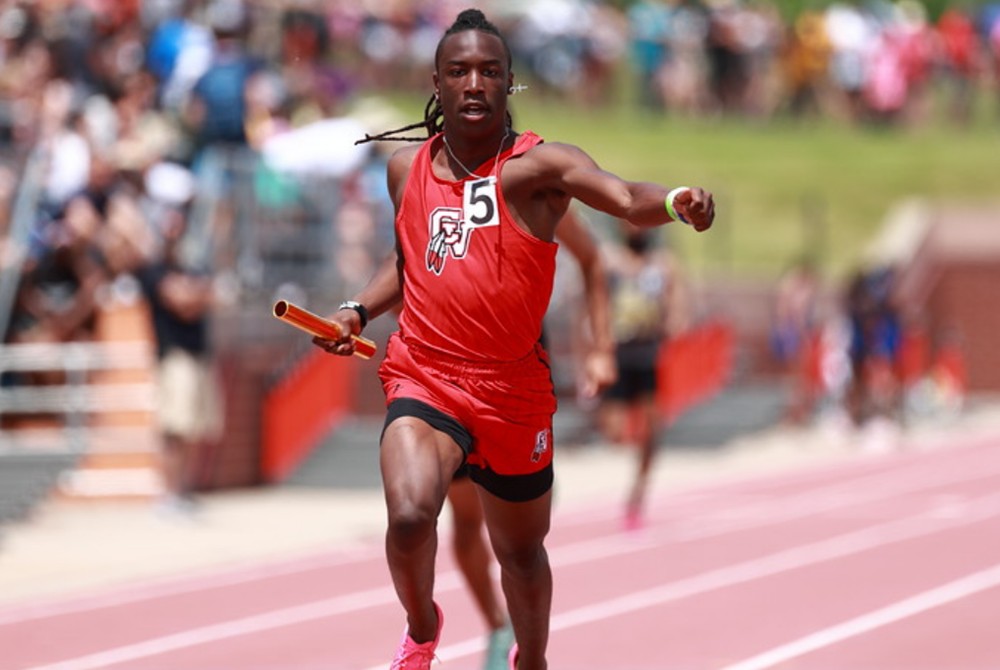
Vicksburg's Wright, Corunna Right On in Claiming LPD2 Championships
By
Steve Vedder
Special for MHSAA.com
June 3, 2023
ADA – If Michael Wright was a baseball player, he probably would've been called out on strikes a year ago.
Instead, the Vicksburg senior can celebrate after winning the 200 at Saturday's Lower Peninsula Division 2 Track & Field Finals at Forest Hills Eastern.
The road to the championship in the 200, via a time of 21.72, was anything but a straight line for Wright. An aspiring baseball player, he was cut from the Vicksburg squad as a freshman. His football career, by Wright's own admission, was "on and off." And then a year ago in his first track meet, Wright suffered a leg injury that virtually ended his season. He did return to finish fifth in the 200 at Finals while helping the 400 relay team to a 16th place.
So there is nothing to realistically explain how Wright found himself in the position Saturday at sweltering Forest Hills Eastern to win a championship. Except for returning this season to break the school record in the 200 four times in two months. Well, that and willpower and simple desire.
 "I knew I could finish high, maybe in the top five. But this is better," said Wright, who credits drinking large quantities of milk for his resurgence. "I looked to football because I didn't think I could bounce back for track. But I overcame the bumps, the obstacles."
"I knew I could finish high, maybe in the top five. But this is better," said Wright, who credits drinking large quantities of milk for his resurgence. "I looked to football because I didn't think I could bounce back for track. But I overcame the bumps, the obstacles."
While Wright was jump-starting his track career, Corunna won the team title with 41 points. Mason and Forest Hills Eastern tied for second with 35. Whitehall was fourth with 33 points, and Frankenmuth fifth with 29 points.
Corunna coach Jeff Sawyer, who had never won a Finals title in 37 years coaching at Owosso and three more at Corunna, said the championship came after little fanfare during the season. Virtually right up until the time Corunna hauled off its first-place trophy, Sawyer said it was never really on his team's mind. The title came after the team managed only a runner-up finish at the Regional.
"We kind of low-keyed it," he said. "We knew scoring 40 points was possible. We lost to Frankenmuth by one point at the Regional. … We were a little disappointed we didn't win, but we had some good times today. We knew it was possible.
"Every day we just come and do what we do. We talk about getting better every day with PRs (personal records). And we're still getting better because we have some tough guys. Just competitive, tough kids. But we were the underdogs."
Corunna had only two firsts on Saturday, in the 400 relay (42.63) and Wyatt Bower in the long jump (22-8½).
Among the individual highlights was Frankenmuth senior Dalton DeBeau, who successfully defended his Finals title in the discus (171-6). He was fifth in that event as a sophomore and after winning a year ago, was considered a good bet to repeat.
"I kind of expected it," said DeBeau, who will compete at Michigan State next spring. "There wasn't a lot of pressure. I knew what had to be done. I threw 160 feet on my first throw to get in the finals, and that helped right away. I knew I could go all out."
 Berrien Springs' Jake Machiniak won the 100 (10.54) while the team also captured the 800 relay (1:28.18). Machiniak said his season hasn't been without its share of difficulties. There was a time when he couldn't seem to come out of the starting blocks smoothly. But beginning with the conference meet where he ran school record 10:73, Machiniak felt himself back on course.
Berrien Springs' Jake Machiniak won the 100 (10.54) while the team also captured the 800 relay (1:28.18). Machiniak said his season hasn't been without its share of difficulties. There was a time when he couldn't seem to come out of the starting blocks smoothly. But beginning with the conference meet where he ran school record 10:73, Machiniak felt himself back on course.
"There were ups and downs. I struggled in the middle of the season," he said. "But my teammates helped me through some difficulties. I came here to finish the job; I knew I could do something here."
Mason's Tyler Baker won the 100 hurdles (14.63) to complete a long journey that included finishing just ninth in last year's prelims. The success was as simple as putting in loads of offseason work.
"I practiced and did stuff about every day," he said. "I might not be the fastest, but I make up for that in form. It's a fine-tuning thing. Everyone wants to be faster."
Mason also got a championship from A.J. Mantel, who captured the 300 hurdles (38.90).
Among other highlights was Forest Hills Eastern senior Aiden Sullivan successfully defending a 2022 title on his own home turf. He won Saturday's 800 (1:53.92).
Adrian won the 3,200 relay (7:39.77), while Grand Rapids Christian took the 1,600 (3:24.49).
Alma had two individual winners in Michael Howey in the shot (55-08) and Jacob Dunlap in the high jump (6-7).
The other champs were Kyle Eberhard of Linden in the 1,600 (4:14.79), Whitehall's Trannon Ayler in the 400 (48.83), Freeland's T.J. Hansen in the 3,200 (9:11.56) and Sam Vesperman of Grosse Ile in the pole vault (15.01). Chelsea senior Jacob Nelson competed in the adaptive 100 (27.28), 200 (57.71) and shot put (6-6).
PHOTOS (Top) Vicksburg's Michael Wright celebrates after winning the 200 on Saturday. (Middle) Corunna's Tarick Bower enjoys a moment after anchoring the winning 400 relay. (Below) Mason's Tyler Baker, center, works to stay ahead in the 110 hurdles. (Photos by Dave McCauley/RunMichigan.com.)

Chippewa Valley's Heard Has Big Plans to Add to All-Time Sprint Legacy
By
Keith Dunlap
Special for MHSAA.com
May 10, 2024
CLINTON TOWNSHIP — Clinton Township Chippewa Valley senior Shamar Heard admits he’s thought about it, and for good reason.
 After all, why not at least entertain the thought of doing something unprecedented in state history when it comes to track & field?
After all, why not at least entertain the thought of doing something unprecedented in state history when it comes to track & field?
Two years ago as a sophomore, Heard achieved the double in the fastest races, winning both the 100 and 200-meter dashes at the Lower Peninsula Division 1 Finals.
Last year, Heard completed the trifecta when it came to sprint state titles, focusing solely on the 400 dash and winning that event in 47.78 seconds while also running on first and third-place relays.
So, how about trying to train for and win all three events this year as a senior? Who in the state would be able to stop him?
“I definitely have been thinking about it,” Heard said. “Because why not? It probably hasn’t been done in a long time, if ever.”
But while the thought has crossed his mind, it won’t happen. It’s a little much on the body — in particular running the 100-meter dash — to try and do all three at once.
However, Heard in the coming weeks is still in a good position to cement what already is a place among the greatest sprinters to come through the state of Michigan.
First, he has big things in mind for his specialty race, the 400 meters. He has won two consecutive AAU national titles in that event in addition to the Finals title he won last year, but is craving more.
“I want to be at 45 seconds for the state meet,” Heard said noting the June 1 Finals at East Kentwood.
In addition, Heard plans on competing in the 200 meters at East Kentwood. He also is a part of Chippewa Valley’s 800 relay team that won last year in 1:26.41. He’s expected to qualify for all three at the Regional on May 17 at Romeo.
 When Heard is done with high school, he will continue running track at Tennessee.
When Heard is done with high school, he will continue running track at Tennessee.
It’s all mighty impressive for a speedster that Chippewa Valley head coach Terry Wilson said hates lifting weights and is “barely above 150 pounds.”
“He doesn’t weigh a whole lot, but he generates a lot of power,” Wilson said. “His strength-to-weight ratio has to be astronomical. He’s just gotten better with his form.”
Throughout his entire life, Heard said he’s simply loved racing. When he was a kid, he would constantly pick out a stop sign on a street or another spot in a yard and race others to the finish, often beating them with ease.
When he was 10 years old, he was invited by a friend to come out for a track team, and he proceeded to beat others in races continuously.
As he got a little older, Heard discovered how gifted he was running the 400 meters and started to focus more on that event.
Heard said he loves the 400 meters so much mostly because he loves embracing a challenge many sprinters don’t want to face.
“I like that not many people want to go through that pain,” he said. “I take it as a compliment when people look at (the 400) and they say, ‘Hey, people are crazy for doing that.’ That makes me motivated to do it.”
Wilson admits there doesn’t have to be much coaching done with Heard. It’s just simply a matter of getting together before races to discuss how he feels and what his body can do that day.
“He understands his body a little bit better every year,” Wilson said. “He understands what he needs to get done in races. He’ll run the 200 in practice and I’ll have a stopwatch on him, and he’ll say, ‘That felt like a 24 (seconds). I look at my stopwatch and it’s a 24.2. He has that ability to gauge how fast he’s going. It’s just different with him.”
Heard also was a football player at Chippewa Valley, but gave the sport up before last fall to focus solely on his track career.
“I was just looking at the bigger picture,” Heard said. “I was more consistent in one sport than I was the other.”
He will run the 400 meters at Tennessee, and then the sky could be the limit given what he’s accomplished already on a national level.
Until then though, Heard will spend the rest of his high school career trying to win more hardware and leave a mark that might be impossible for future sprinters in Michigan to surpass.
“I want to give everyone a senior year that they will remember,” Heard said. “I want to go out with one of the most memorable years of a high school athlete.”
 Keith Dunlap has served in Detroit-area sports media for more than two decades, including as a sportswriter at the Oakland Press from 2001-16 primarily covering high school sports but also college and professional teams. His bylines also have appeared in USA Today, the Washington Post, the Detroit Free Press, the Houston Chronicle and the Boston Globe. He served as the administrator for the Oakland Activities Association’s website from 2017-2020. Contact him at [email protected] with story ideas for Oakland, Macomb and Wayne counties.
Keith Dunlap has served in Detroit-area sports media for more than two decades, including as a sportswriter at the Oakland Press from 2001-16 primarily covering high school sports but also college and professional teams. His bylines also have appeared in USA Today, the Washington Post, the Detroit Free Press, the Houston Chronicle and the Boston Globe. He served as the administrator for the Oakland Activities Association’s website from 2017-2020. Contact him at [email protected] with story ideas for Oakland, Macomb and Wayne counties.
PHOTOS (Top) Chippewa Valley’s Shamar Heard crosses the finish line while anchoring the winning 800 relay at last year’s LPD1 Finals. (Middle) Heard prepares to run the winning 400 at last season’s championship meet. (Click for more from Jamie McNinch/RunMichigan.com.)

